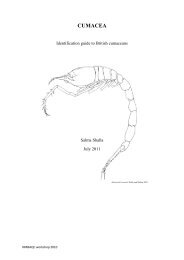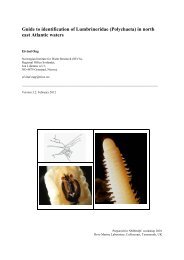s A Field Guide to the British Seaweeds - NMBAQC
s A Field Guide to the British Seaweeds - NMBAQC
s A Field Guide to the British Seaweeds - NMBAQC
You also want an ePaper? Increase the reach of your titles
YUMPU automatically turns print PDFs into web optimized ePapers that Google loves.
- Turfs of mixed species including a variety of morphological forms<br />
• Epiphytes – algae growing on o<strong>the</strong>r host algal species – for example:<br />
- Elachista sp. and Ulothrix sp. on Fucus<br />
- Li<strong>to</strong>siphon sp. on Alaria and Chorda.<br />
- Encrusting Corallines on Polyides<br />
- Many small epiphytes on various filamen<strong>to</strong>us species such<br />
as Cladophora<br />
- Red epiphytes on kelp stipes<br />
• Endophytes – algae growing in o<strong>the</strong>r host algal species – for example:<br />
- Chlorochytrium/Sykidion spp. in a variety of host species<br />
- Myrionema strangulans in Palmaria and Enteromorpha<br />
sp.<br />
- Variety of Chlorophyta, Phaeophyta and Rhodophyta sp.<br />
in Cladophora, Polysiphonia and Ceramium<br />
- Many small filamen<strong>to</strong>us epiphytes in gelatinous red and<br />
brown algae and particularly in decaying distal portions of<br />
Dumontia and Chorda<br />
• Epizoans – algae growing on faunal species – for example:<br />
- Audouinella sp. on hydroids<br />
- Ralfsia on Limpet shells<br />
Reduced species list identification guide as required by <strong>the</strong> Water Framework Directive 4




